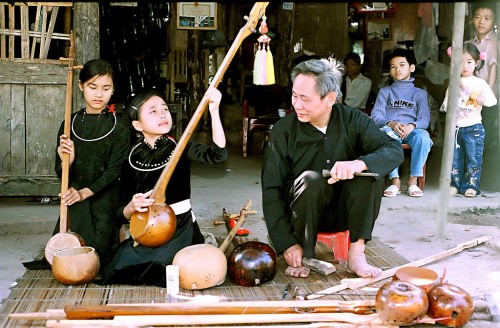“Then” singing seeks UNESCO recognition as world cultural heritage
Vinh Phong -
(VOVworld) - The Ministry of Culture, Sports, and Tourism is compiling a dossier to submit to UNESCO for recognition as a world cultural heritage. This is a great opportunity for Then singing to become better known around the globe. VOV’s Vinh Phong spotlights efforts to preserve this special music genre of Vietnam:
People from different regions of Vietnam have their own cultural identities. Ca Tru singing, quan ho folksongs, and water puppetry are sources of pride for people in the northern delta region, amateur singing is popular in the southern region. Vi and Dam folksongs and chants are important parts of cultural life of the central region. And “then” singing is a typical music genre of the Tay, Nung, and Thai ethnic minorities in Vietnam’s northern mountains. “Then” songs are often sung around a camp fire at night when people gather to eat and talk after a hard day’s work. “Then” singing is accompanied by a musical instrument called a “dan tinh” - a sound-box made from a dried gourd covered in thin wood, with a long handle. “Then” means “sky” in the Tay language, so “Then” singers and dancers at local festivals are considered community representatives for communicating with the deities to ask for bumper crops and a prosperous and happy life. “Then” singing is known for its soft, insistent rhythms. Originated by the Tay, “then” singing became popular among the Nung and the Thai people and is now practiced in 14 provinces and cities across Vietnam. Besides being of great spiritual significance, “Then” songs praise of the fatherland, its beautiful landscape and people. Director Nguyễn Vũ Phan of the Tuyen Quang provincial Department of Culture, Sports, and Tourism, told VOV: "The traditional art of “then” singing has almost fallen into oblivion. There are currently very few artists who have mastered this art form. Without measures and plans to preserve then singing, the art form will be lost forever. As we are compiling a dossier to submit to UNESCO for recognition of the art form as a world cultural heritage, it’s urgent to intensify efforts to preserve this musical genre."
 |
Artisan Hà Thuấn is instructing young singers to practice then singing and play "dan tinh". (Photo: internet)
|
Like other cultural heritages of Vietnam, “Then” singing is on the verge of extinction as the number of artisans who help pass down the art form to the younger generations is dwindling. Nguyen Vu Phan says there are only 2 artists left in Tuyen Quang province and few of the 40 Tay ethnic people appointed to popularize and preserve the genre can sing the ancient songs. Hoàng Thành Khởi, Head of the Culture and Information Division of Lang Son province’s Van Quan district, says local authorities’ plans to preserve then singing were abandoned due to a shortage of funds and human resources. Bình Phú commune in Lang Son province is one of few localities that still supports “Then” singing art troupes. However, members of these groups only meet 4 times a year to practice and perform then singing. Lê Văn Toàn, Head of the Vietnamese Institute for Musicology, says the institute is cooperating with authorities from the 14 provinces that still practice “then” singing to assess the current state of preservation work before compiling the dossier for UNESCO. Toan told VOV: "This is a unique art form that is full of vitality. It’s essential for us to assess the current status of the art form to determine appropriate measures to protect it. We need specific solutions to make the public more familiar with “then” singing and recognize that it is a precious cultural heritage that urgently needs protection."
Much effort is needed to help “Then” singing become recognized as a world heritage. This should include mobilizing more and more to protect and promote the genre, and inclduing the art form in school curriculums to familiarize younger generations with this national heritage.
Vinh Phong